hydrogen
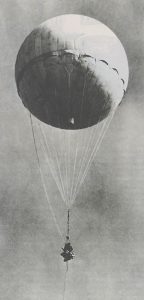 I suppose a true World War II history buff might know about some of the strange war stories there are out there, and I rather thought I was becoming a World War II history buff, but I had never heard of the Japanese Balloon Bombs. I can’t imagine how a nation could send a random bomb over another nation, not knowing where it will land, or who it will kill…but then, the evil we have seen in the 21st century has proven to be very much the same. I guess there really is nothing new under the sun. Where evil exists, horrible things happen. Such was the case with the Japanese Balloon Bombs. The Japanese were an evil nation at that time, and they didn’t care who they hurt. in 1945, a Japanese Balloon Bomb landed in rural Oregon, ad killed six people . As it turns out, these were the only World War II combat casualties within the continental 48 states. Apparently, the accuracy of the balloon bombs left something to be desired…thankfully.
I suppose a true World War II history buff might know about some of the strange war stories there are out there, and I rather thought I was becoming a World War II history buff, but I had never heard of the Japanese Balloon Bombs. I can’t imagine how a nation could send a random bomb over another nation, not knowing where it will land, or who it will kill…but then, the evil we have seen in the 21st century has proven to be very much the same. I guess there really is nothing new under the sun. Where evil exists, horrible things happen. Such was the case with the Japanese Balloon Bombs. The Japanese were an evil nation at that time, and they didn’t care who they hurt. in 1945, a Japanese Balloon Bomb landed in rural Oregon, ad killed six people . As it turns out, these were the only World War II combat casualties within the continental 48 states. Apparently, the accuracy of the balloon bombs left something to be desired…thankfully.
The idea of a balloon bomb was to send in a bomb that was silent. The problem is that balloons are hard to control. They go with the flow of the wind currents, so you don’t know where they will land. Then again, the Japanese were at war with the world, so they really didn’t care where the balloons would land. The six people who were killed by the Fu-Go or fire-balloon bomb, as they were called, were a Sunday School teacher Elyse Mitchell (and her unborn child), her 13 and 14 year old students, Jay Gifford, Edward Engen, Sherman Shoemaker, Dick Patzke, all of whom were killed instantly, when the bomb exploded. Dick Patzke’s sister, Joan was severely burned, and died moments later. The group had stopped for a moment, because Elyse Mitchell was feeling ill, and while her husband, Reverend Archie Mitchell talked with construction workers in the area, the six victims went to investigate a balloon they saw. It would prove to be a fatal mistake. The group had been going on a Saturday afternoon picnic near Klamath Falls, Oregon. They had only walked about 100 yards from the car. One of the road-crew workers, Richard Barnhouse, said “There was a terrible explosion. Twigs flew through the air, pine needles began to fall, dead branches and dust, and dead logs went up.”
Made of rubberized silk or paper, each balloon was about 33 feet in diameter. Barometer-operated valves released hydrogen if the balloon gained too much altitude or dropped sandbags if it flew too low. The balloons were filled with 19,000 cubic feet of hydrogen and the jet stream drew them eastward. They were designed to travel across the Pacific to North America, where they would drop incendiary devices or anti-personnel explosives. I would think the hydrogen alone would make a horrible bomb, but attached to the 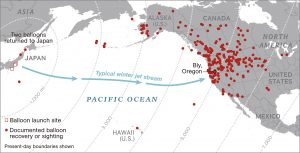 balloon was the actual bomb. The Japanese released an estimated 9,000 fire balloons during the last months of World War II. At least 342 reached the United States, with some drifting as far as Nebraska. Some were shot down. Some caused minor damage when they landed, but no injuries. One hit a power line and blacked out the nuclear-weapons plant at Hanford, Washington. But the only known casualties from the 9,000 balloons…and the only combat deaths from any cause on the U S mainland were the five kids and their Sunday school teacher going to a picnic. What a valiant victory for the Japanese that was.
balloon was the actual bomb. The Japanese released an estimated 9,000 fire balloons during the last months of World War II. At least 342 reached the United States, with some drifting as far as Nebraska. Some were shot down. Some caused minor damage when they landed, but no injuries. One hit a power line and blacked out the nuclear-weapons plant at Hanford, Washington. But the only known casualties from the 9,000 balloons…and the only combat deaths from any cause on the U S mainland were the five kids and their Sunday school teacher going to a picnic. What a valiant victory for the Japanese that was.
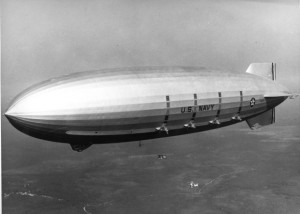
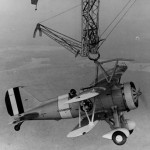 I think most of us have heard of the Hindenburg…the hydrogen filled blimp like airship the crashed in a ball of fire on May 6, 1937, bringing with it a loss of 36 lives…amazing when you consider that there were 97 people on board when that ball of fire crashed. What many people may not know is that the Hindenburg was not the only hydrogen powered airship. The USS Macon (ARS-5), named for Macon, Georgia and operated by the United States Navy for scouting and served as a “flying aircraft carrier” as well. It was designed to carry biplane parasite aircraft. Macon held single seat Curtiss F9C Sparrowhawks for scouting or two seat Fleet N2Y-1 for training. The Macon was a little under 20 feet shorter than the Hindenburg. The USS Macon also had a sister ship…the USS Akron (ARS-4).
I think most of us have heard of the Hindenburg…the hydrogen filled blimp like airship the crashed in a ball of fire on May 6, 1937, bringing with it a loss of 36 lives…amazing when you consider that there were 97 people on board when that ball of fire crashed. What many people may not know is that the Hindenburg was not the only hydrogen powered airship. The USS Macon (ARS-5), named for Macon, Georgia and operated by the United States Navy for scouting and served as a “flying aircraft carrier” as well. It was designed to carry biplane parasite aircraft. Macon held single seat Curtiss F9C Sparrowhawks for scouting or two seat Fleet N2Y-1 for training. The Macon was a little under 20 feet shorter than the Hindenburg. The USS Macon also had a sister ship…the USS Akron (ARS-4).
The USS Macon was in service less than two years, when on February 12, 1935 it was damaged in a storm and crashed off California’s Big Sur coast. Most of the crew was saved, and the wreckage remains on the ocean floor. The site of the wreckage remains on the United States National Register of Historic Places. I find myself interested in things like shipwrecks and plane crashes, but the ones underwater are especially interesting, because they are so inaccessible to most people. The USS Macon, like the Hindenburg proved not to be the best choice of an airship. There were really to many conditions that could easily bring them down. And the fact that they contained so much helium made then a flying bomb, in all reality. I don’t suppose that was something they considered when making these machines, but I’m sure it later became the reason that they discontinues this type of airship. I find it quite sad that it too two crashes to realize that they were not the safest way to fly.
I suppose they served their purpose though. I think it’s amazing that they could actually carry a plane on a hook and let it take off from the air. Launching and recovery from the airship in flight was done using a skyhook. The Sparrowhawk had a hook mounted above its top wing that attached to the cross-bar of a trapeze mounted on the carrier airship. For launching, the trapeze was lowered clear of the hull into the moving airship’s slipstream. With engine running, the Sparrowhawk would then disengage its hook and fall away from the airship. For recovery, the biplane would fly underneath the airship, until it was beneath the trapeze. The 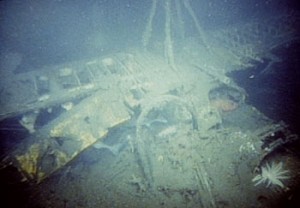
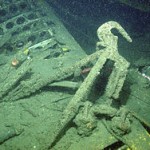 pilot would climb up from below, and hook onto the cross-bar. Once the Sparrowhawk was secure, it could be hoisted by the trapeze back within the airship’s hull, the engine was cut as it passed the hangar door. To me, this seems like a tricky maneuver, but the pilots soon learned the technique and said it was much easier than landing on a moving aircraft carrier. Soon, the pilots acquired the nickname “The men on the Flying Trapeze” and their aircraft were decorated with appropriate emblems. Now to me…that is cool!!
pilot would climb up from below, and hook onto the cross-bar. Once the Sparrowhawk was secure, it could be hoisted by the trapeze back within the airship’s hull, the engine was cut as it passed the hangar door. To me, this seems like a tricky maneuver, but the pilots soon learned the technique and said it was much easier than landing on a moving aircraft carrier. Soon, the pilots acquired the nickname “The men on the Flying Trapeze” and their aircraft were decorated with appropriate emblems. Now to me…that is cool!!
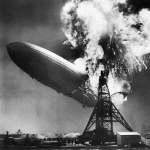 Through the years, or at least since the dawning of flight, man has tried to build flying machines that are more and more creative. Some of these have had amazing runs, like the B-17 Bomber, which was a World War II era plane, that still flies today. Others, like the Hindenburg, went down in a ball of flames. I don’t think it’s usually easy to predict which ones will succeed and which ones won’t. I seriously doubt that people would have predicted that the Concord would ever have the problems it had, or that the Goodyear Blimp would prove successful, where the Hindenburg failed. Sometimes, it’s all about finding yourself with just the right set of components, or making just one slight mistake…and sometimes, the mistake is more obvious.
Through the years, or at least since the dawning of flight, man has tried to build flying machines that are more and more creative. Some of these have had amazing runs, like the B-17 Bomber, which was a World War II era plane, that still flies today. Others, like the Hindenburg, went down in a ball of flames. I don’t think it’s usually easy to predict which ones will succeed and which ones won’t. I seriously doubt that people would have predicted that the Concord would ever have the problems it had, or that the Goodyear Blimp would prove successful, where the Hindenburg failed. Sometimes, it’s all about finding yourself with just the right set of components, or making just one slight mistake…and sometimes, the mistake is more obvious.
The Hindenburg disaster, which occurred on this day, May 6, 1937, was probably the worst slight mistake in history. The Hindenburg was Germany’s version of the most luxurious way to fly in existence at that time. It was over 800 feet long and with its state of the art Mercedes Benz engine, it flew at 85 miles per hour, and had a range of 8,000 miles. The Hindenburg carried 97 passengers, and made ten successful ocean crossings the year before the disaster. It was Germany’s Nazi government’s symbol of national pride, but it held a secret mistake that, on May 6, 1937, exploded into one of Germany’s biggest failures.
The Hindenburg was filled with seven million cubic feet of Hydrogen. The Germans used Hydrogen because of its maneuverability, even though Helium would have been much safer. The Hindenburg was supposed to arrive in New Jersey at 5:00am on that fateful day, but bad weather delayed its arrival until the later afternoon. Even then, the weather was not ideal. Rain further delayed the docking at Lakehurst. When they were finally cleared to dock, Captain Max Pruss brought the ship in too fast and had to order a reverse engine thrust. At 7:20pm a gas leak was noticed. Within minutes, the tail blew up, sending flames hundreds of feet in the air and as far down as the ground below.
The chain reaction that followed caused the entire vessel to burst into flames. There were nearly 1,000 spectators awaiting the arival, who could feel the heat of the fire from a mile away. Those on the Hindenburg 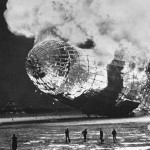 tried to jump. Some tried to jump to the docking cables, and when they fell, they were killed or critically injured. Others tried to jump as they got closer to the ground. Many were critically burned. In all 36 people lost their lives, while 56 managed to survive. Probably the main reason this crash has stayed in the minds of people over the years is that there were so many cameras to document the event. The photographs have become well known. Announcer Herbert Morrison, on WLS radio gave an unforgettably harrowing live account of the disaster, “Oh, oh, oh. It’s burst into flames. Get out of the way, please . . . this is terrible . . . it’s burning, bursting into flames, and is falling . . . Oh! This is one of the worst . . . it’s a terrific sight . . .oh, the humanity.” This truly was a disaster of monumental proportion, and it will never be forgotten.
tried to jump. Some tried to jump to the docking cables, and when they fell, they were killed or critically injured. Others tried to jump as they got closer to the ground. Many were critically burned. In all 36 people lost their lives, while 56 managed to survive. Probably the main reason this crash has stayed in the minds of people over the years is that there were so many cameras to document the event. The photographs have become well known. Announcer Herbert Morrison, on WLS radio gave an unforgettably harrowing live account of the disaster, “Oh, oh, oh. It’s burst into flames. Get out of the way, please . . . this is terrible . . . it’s burning, bursting into flames, and is falling . . . Oh! This is one of the worst . . . it’s a terrific sight . . .oh, the humanity.” This truly was a disaster of monumental proportion, and it will never be forgotten.

